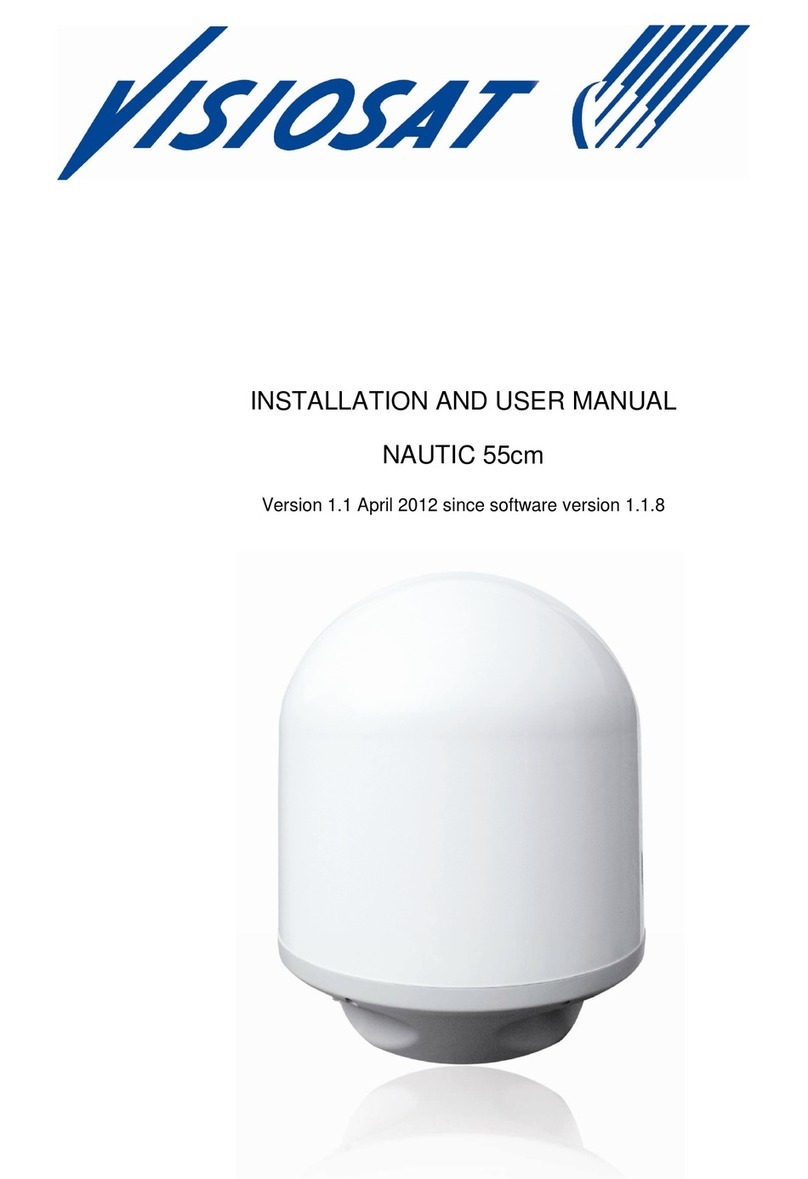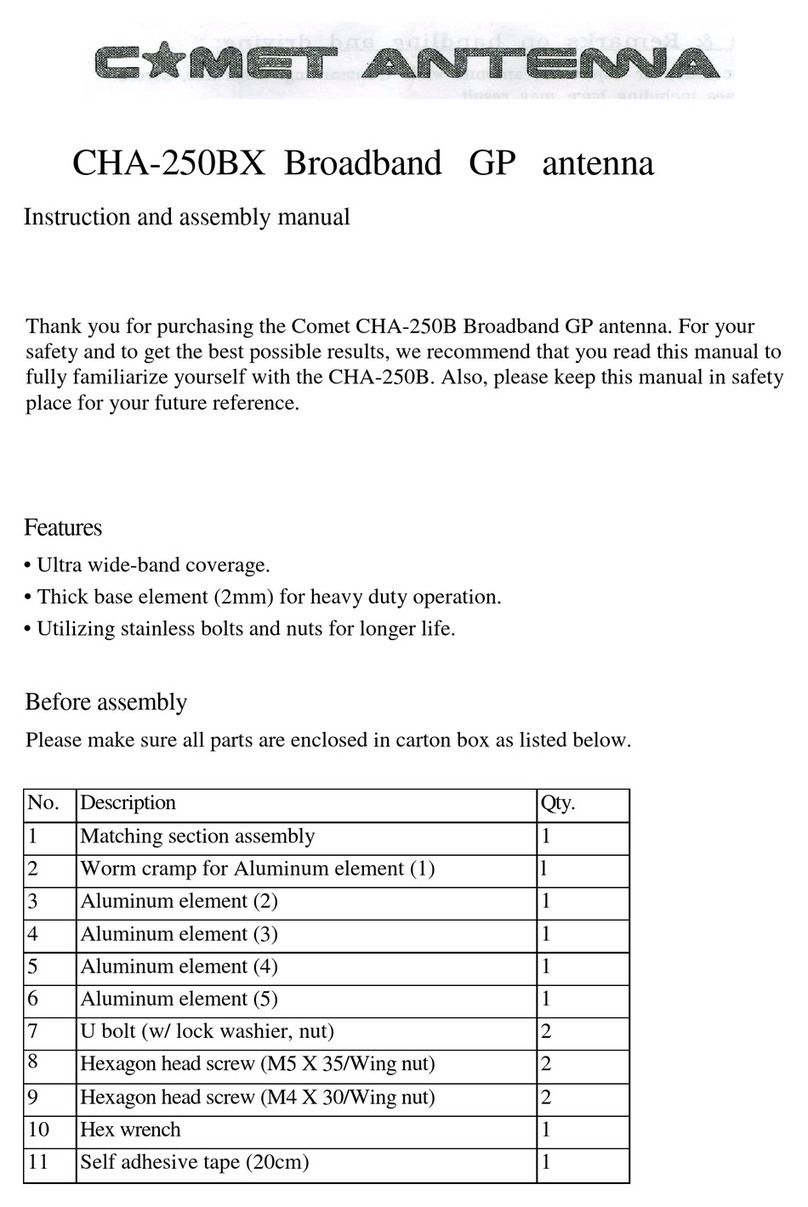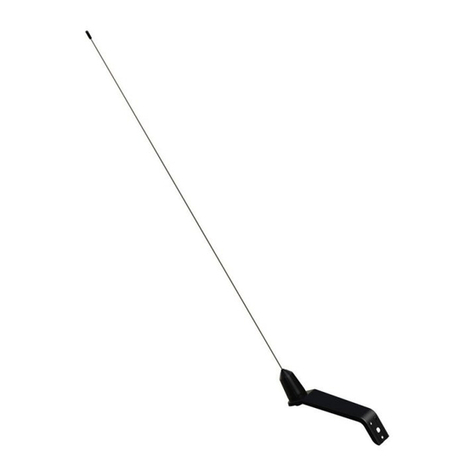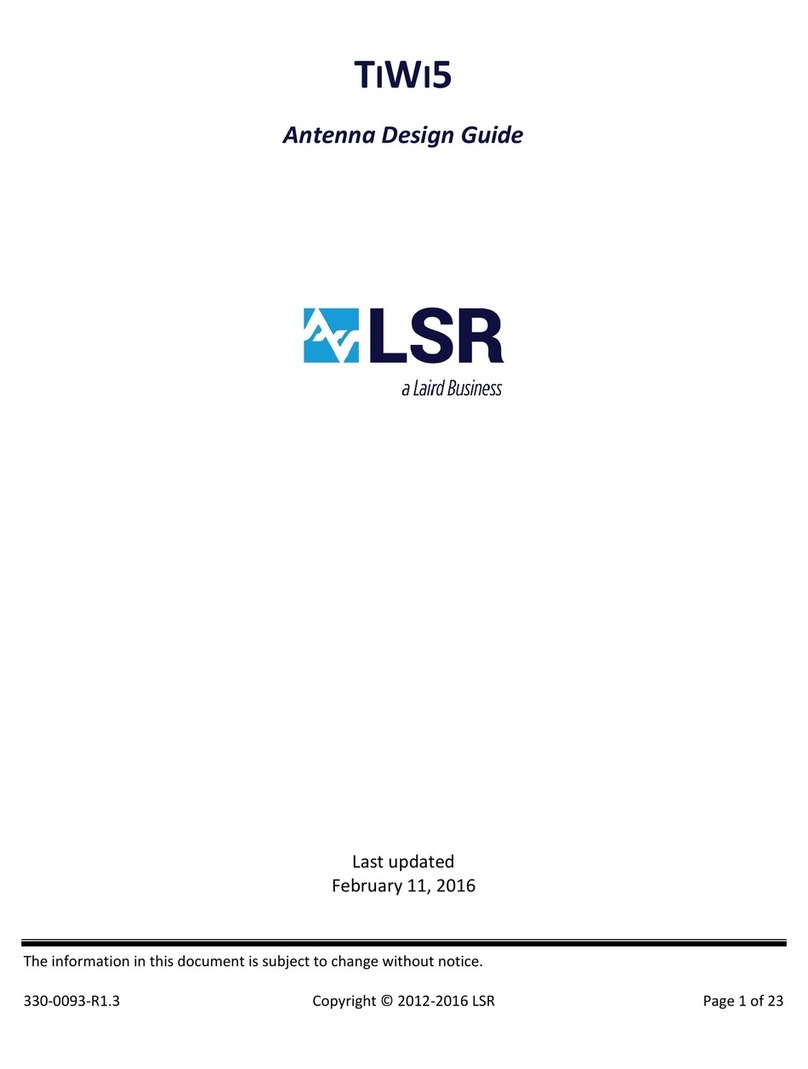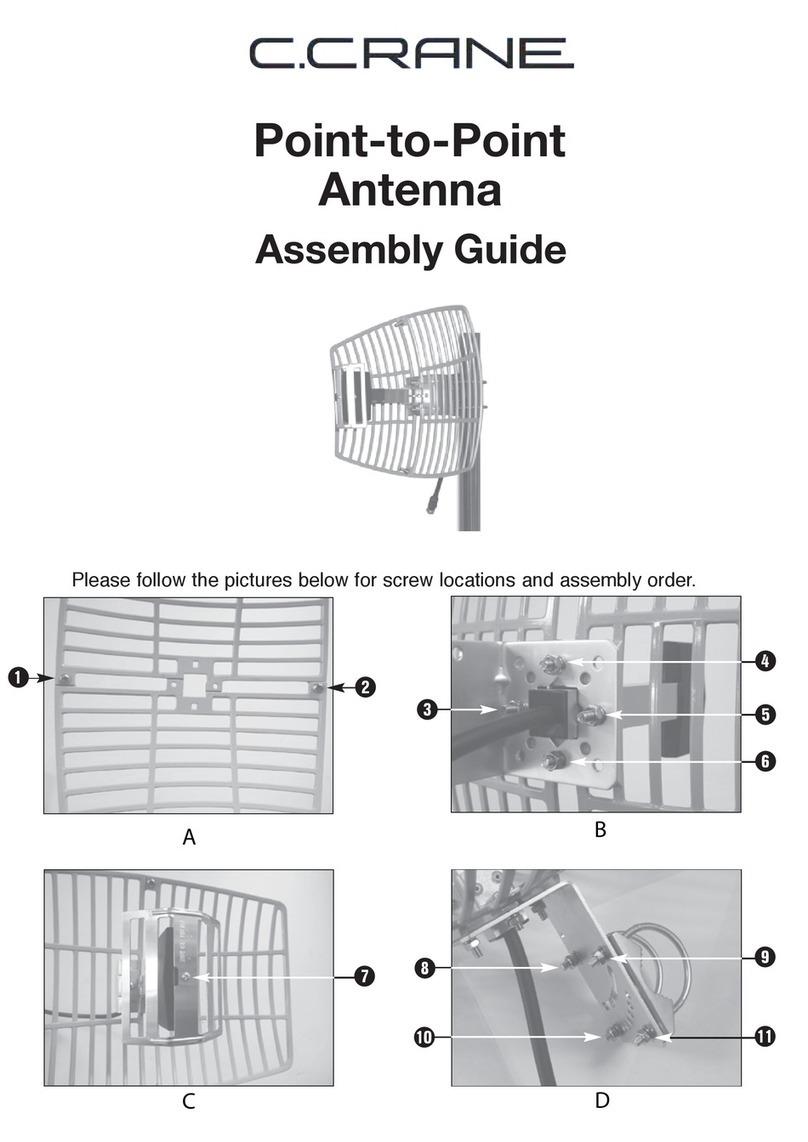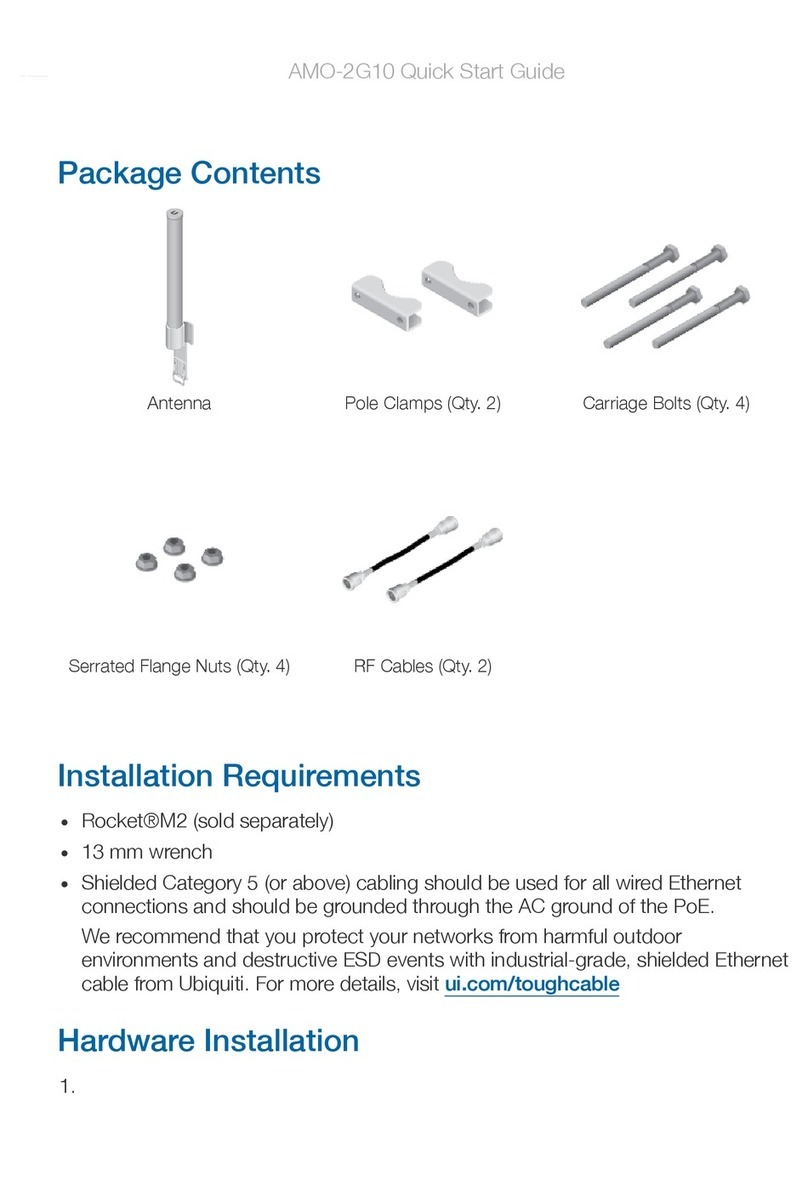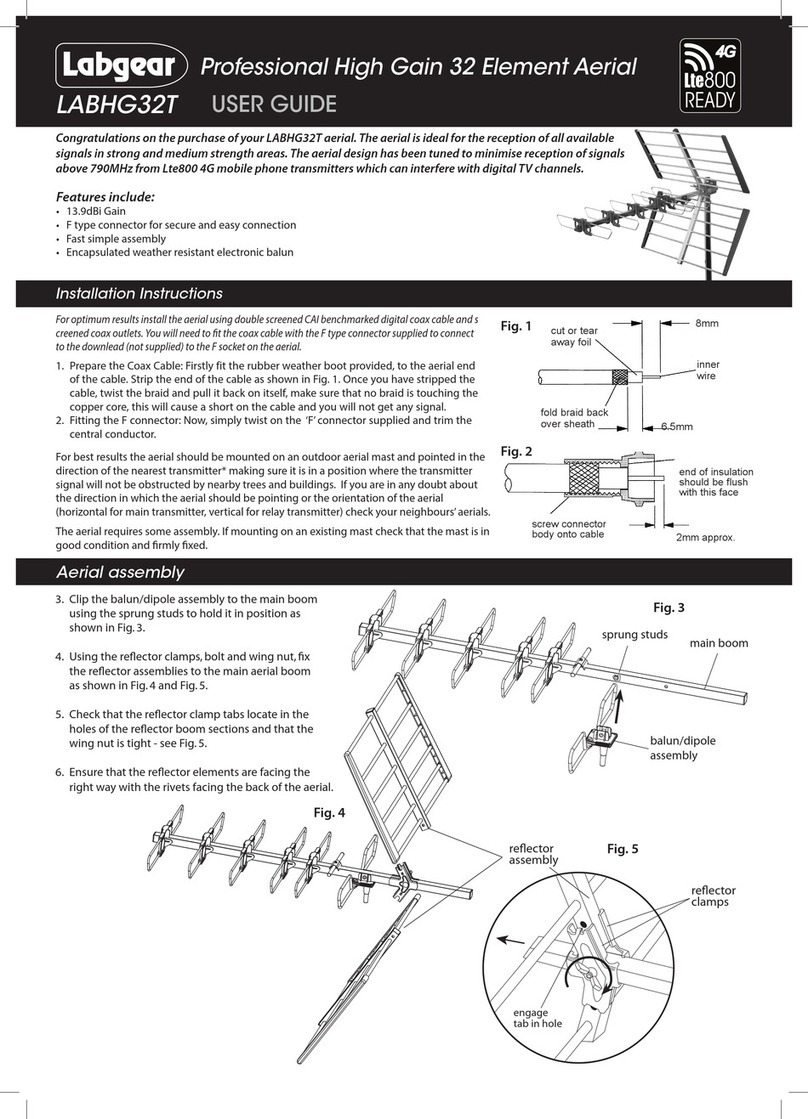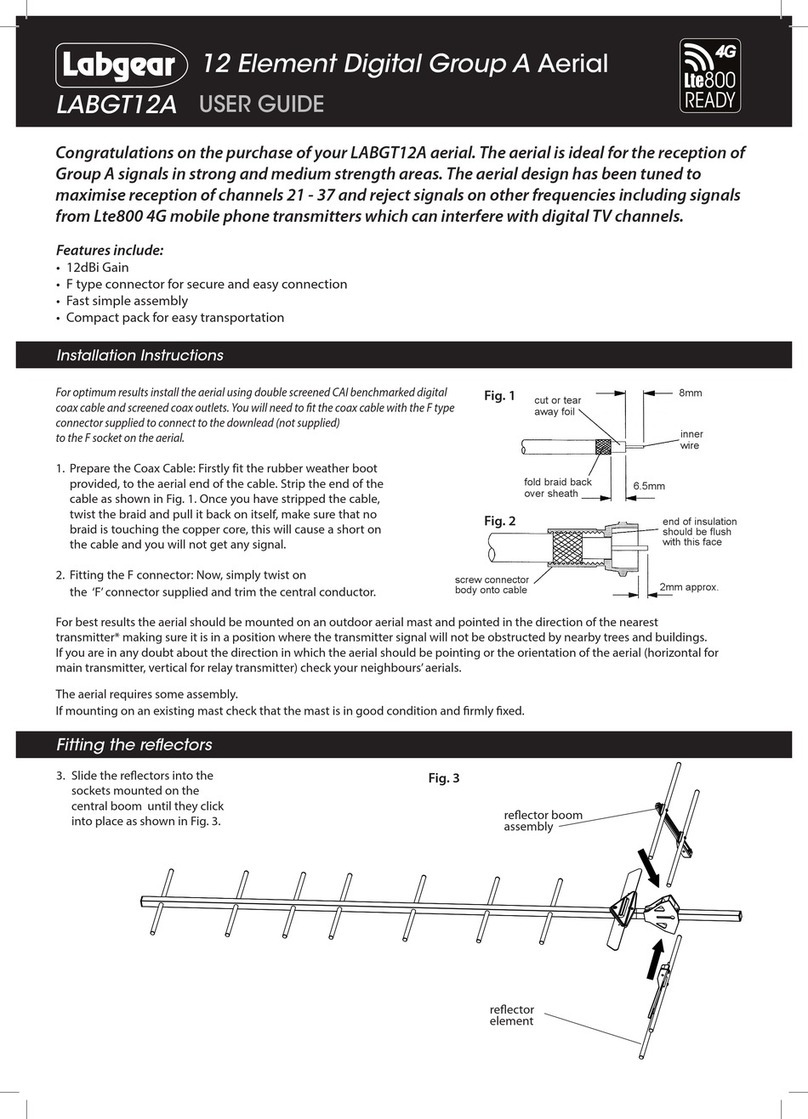General Instrument COLORCASTER PLUS TA-84X User manual

r..
GENERAL
INSTRUMENT INSTRUCTION SHEET
435.666.05
VHFjUHF "COLORCASTERPLUS"TM
MODEL TA-84X
~
D~,
FS-1314FM
Fig. l-TA-84X Four-Set System
SPECIFICAnONS
1
...,..."",~
PASSBANDS,in MHz 54-216and470-890
NUMBEROF OUTPUTS 4
GAIN,at anyoutputwith all othersterminated,in dB 7.5 at LaVHF
(average) 5.5 at Hi VHF
3.5 at UHF
FLATNESS,in dB + 1 at VHF
+2 at UHF
NOISEFIGURE,in dB 5.2 at La,5.8at HiVHF
6 for Chs.14-47
8 for Chs.48-72
10for Chs.73-83
OUTPUTCAPABILITY,perchannel,-eachoutput,in p.V 114,000for 7 chs.VHF
27,000for 5 chs. UHF
MAX.RECOMMENDEDINPUT,perchannel,inp.V 60,000for 7 chs.VHF
19,000for 5 chs. UHF
DISTORTION:Cross-Mod.at max.input 0.5% (-46 dB)
FMBANDATTENUATION(I) 12dBbelowTVbandgain
ISOLATION,betweenoneandanyotheroutput,in dB 15acrosspassbands
TERMINALIMPEDANCE,at all terminals,in 0 300
POWERREQUIREMENTS 117V,60 Hz,65 mA,8.2 W

CAUTION:
TO REDUCETHE RISK OF ELECTRIC SHOCK,
DO NOT REMOVE COVER(ORBACK).
NO USER. SERVICEABLE PARTS INSIDE.
REFERSERVICING TO QUALIFIED SERVICE PERSONNEL.
WARNING: TO PREVENTFIREOR SHOCK HAZARD,
DO NOT EXPOSE THIS APPLIANCE TO
RAIN OR MOISTURE.
&~
Lh
=TQe)iglltnigg tlash witb- agowl1ead $ymbol,
within an equilateral triangle, is intended to
alert the user to the presence of uninsulated
"dangerous voltage" within the product's en-
closure that may be of sufficient magnitude to
constitute a risk of electric shock to persons.
The exclamation point within an equilateral
triangle is intended to alert the user to the
presence of important operating and mainten-
ance (servicing) instructions in the literature
accompanying the appliance.
2
-~

"v
c..>
\'\
'j
(,
r-- -- - -----.
1 , --l I
I
'" , II, I ,-- - - OCTPur,oo JLl
I'" I . A?i::: ' o. IIR'
r-,I RW<ZO' CW' CZO' C", R' ",'/'WSET' I I I
II,"PV,II ,.~., <ZOA ,., = '" C'" I I " , '/'W I
I
II'OOftll WiW ' lc,~, R,O' R202 "0' RZO' R'OS CW8 <2." "05 IIR' II
1
22 " '" 2.2 1'.5
IIW 'W '.' J." '" . I'0, 50, ", 'I,w I
I- = 5% ", ' " ,0 = RS SET2
I - 0 020' CW
I, I ""0' 0205 . 020.' R'O'..,.. I I " , '/2w II
I
L- .J - " 0L- ICI
II - " " "::;'j'" R' I
I , ",' /'WSET'I
II= = = = I'"~ = = IR" , ,/'W I I I
I
I~-- :1
-~2~8~-~J ~::",,/,w""1 I
I
I ~15-34B ce, '/'W JI
I" ,2 -----
--- lII
II ~'~--e'J'C' - n: - I
~ODu'C , -
I
I I : 8'5'"," ~R'05 ClO, II
II~'" ~:~ 1.",'% " ,
II- - - - - -/'0> I II
u~
I
I I 47 ,R 0'0' .
0.0. LID' R,O'
II
(I" II
I
II 2-"." "TlO' Rlw 4T
I= Cl08 CR'02 II
IW ""'8 P.2V ClO' C'"
IClO' 'G.J I I I
I I ~82 ~:~O, C"O CI" =~
II A,O' '/~WT T I I I
IATO '"0 ~I
I
IT, I R'02 CR,O' -'2VOC = I
I' R
\ II;:" I II I(102 1f2W 'N '00' - Cl05 I I I
\
II, R I 1 :r,~~'F I I
\
~
.I ~~ L ~ - - -~ - - B22-B92-~1 I
I~-~o:y,W~-- -- -- -- -- B23-~ JI
\ NOTES,
, I. V~"S5 O'",RW",' 5P,,"'"'0, TRANSISTORQU'ESCENTOPERATING PO,NTS - "-' I
"
A-'0'~0,R5~'J;ANCES'"'NO'"S, OES"NATIONC"O' °'0' 0202 - - - - - - - - - - - - _D~6~E~
I
'-AC' ""COTANeE>"E '" pF, Vc./Cus q 'O ,., I
.C-ACLCN"A"'D""COTANCESTO 10 mA " , , ,
, a ~~. .
II2-NC"B'RS "A"ED WIT' ANASTER." ("'\ P! mw ", "-'l- IJSCHEMATICDIAGRAM
,
. ::i'cv,°'i;G,~S, "~,"c',;':,;,: ;~T5~REF- BAS'NG GND All CHANNEL AMPLIFIER
I O'",R,owm .'£ REFfRRCOTO Bonc" . .
1
'1 'ROC"D,ALe NEASCRED WIT" A 20"'1 vIEw COE C~E IMODel TA-84X
'OU "ETER W ':VI
'\' (I REPRES"iT5 CA""TANeE 0; B B ,
I---,=D== d
1-----
I
----- ---------
1.

REPLACEMENTPARTS LIST
-~
--
;;00
4
Jerrold
Schematic Designations PartNo.
CAPACITORS
-ClOl 128.570
cm, 201, 207 124.113
C102,110, 111,206,210,211 S124-078
C103,113 124-195
C105 127.168
C106 124.172
C108 124-104
C109 124-048
C202 124-061
C203,212 124-087
C204,208 124-064
C205,209 124.300
C213 124-157
DIODES
CR101 137.788
CR102 137-824
RESISTORS
R1 112-743.95
R2,3, 4, 5, 6, 7,8, 9 112.215-95
R102 112.15-95
Jerrold
Schemat.icDesignations Part No.
RESISTORS(Continued)
R103' 112-970-95
R104 112-922-95
R105 112-927-95
R1O6 112.212.95
R201 112-979-95
R202 112-988-95
R203 112-945.95
R204 112-930-95
R205 112-981-95
R206 111-009-95
TRANSFORMERS
Tl B141-233
Tl03 C144-186-01
T201 C144-366-01
TRANSISTORS
0101 SI30-265-01
0201 130-631
0202 130-220
.-

DESCRIPTION
Model TA-84X is a 300 n, four-output, solid-state amplifier for indoor use in
a small MATV distribution system. The unit has a factory-tuned filter which
passes usable FM signals but attenuates strong ones from local FM stations
sufficiently to prevent interference with the TV signals. A built-in d.c. supply
permits operation directlv from a 117 VAC wall outlet. Antenna terminal
impedance is 300 n.
Two keyhole slotted brackets on the housing chassis permit mounting the unit
on any flat surface. Two wood mounting screws are provided with the unit.
MOUNTING
1. For mounting on wood surfaces at least )~inch thick, use the two #6x~"
type AB screws supplied with the unit.
2. For mounting on other surfaces, including plasterboard, attach a wood
panel to the surface as described in para. 3 below, then mount the unit to
the panel with the two #6x~" type AB screws supplied with the unit.
3. Wood panel to be Jt inch thick plywood or equal, at least 4Jt"xI8", attached
to the surface at a minimum of two points at least 8" apart to:
a. Studs: use #lOxHf" round head wood screws with flat washers;
b. Hollow Cement Blocks: use J4"x3Jt" butterfly bolts with flat washers;
c. Other Masonry: use J4"xlW' expansion bolts with flat washers.
RF CONNECTIONS
The antenna down-lead and indoor distribution leads should be kept as short
as practical. They must be routed at least 7 inches away from any metal sur-
faces and from electrical devices such as motors, heaters, etc.
Connect the antenna down-lead to the amplifier input by cutting the lead end
square and securing it under the screw and crown washer terminals. Where
foam type twin-lead is used, connect it at an angle as illustrated to insure
proper electrical contact.
Similarly connect the amplifier outputs with twin-leads through appropriate
matching transformers or splitters to the TV sets as illustrated.
SERVICING
For the benefit of qualifieq. ser-
vice personnel, a schematic circuit
diagram and a replacement parts
list are given here.
Fig. 2-Connecting the Twin-Leads
~~
WARNING: TO PREVENT FIRE OR SHOCK HA~ARD,~.DO NOT
qPOS_E THIS APPLIANCE TO RAIN OR MOISTURE.
-- .~- ""'=- ""- 5' = '" ~

INSTRUCTION MANUAL
435-953-00
IMPORTANT SAFEGUARDS
1. Read Instructions - All the safety and
operating instructions should be read before
the applianceisoperated.
2. Retain Instructions - The safety and
operating instructions should be retained for
future reference.
3. Heed Warnings - All warnings on the
appliance and in the operating instructions
should be adhered to.
4. Follow Instructions - All operating
and useinstructionsshouldbe followed.
5. Cleaning - Unplug this video product
from the wall outlet before cleaning. Do not
use liquid cleaners or aerosol cleaners. Use a
damp cloth for cleaning.
6. Attachments - Do not use attachments
not recommended as they may cause hazards.
7. Water and Moisture - Do not use this
equipment near water -for example, near a
bath tub, wash bowl, kitchen sink, or laundry
tub, in a wet basement, or near a swimming
pool, and the like.
8. Accessories - Do not place this video
product on an unstable cart, stand, tripod,
bracket, or table. The video product may fall,
causing serious injury and serious damage to
the appliance. Use only with a cart, stand,
tripod, bracket, or table recommended by the
manufacturer, or sold with equipment. Any
mounting of the appliance should follow the
manufacturer's instructions, and should use a
mounting accessory recommended by the
manufacturer.
9. Ventilation - Slots and openings in the
cabinet are provided for ventilation and to en-
sure reliable operation of the equipment and
to protect it from overheating. The openings
should never be blocked by placing the video
product on a bed, sofa, rug, or other similar
surface. Equipment should never be placed
near or over a radiator or heat register, or in
a built-in installation such as a bookcase or
rack unless proper ventilation is provided.
10. Power Sources - This video product
should be operated only from the type of
power source indicated on the marking label.
If you are not sure of the type of power supply
to your home, consult your local power com-
pany. For equipment intended to operate
from battery power, or other sources, refer to
the operating instructions.
11. Ground or Polarization - Thisequipment
may be equipped with a polarized alternating-
current line plug (a plug having one blade wid-
er than the other). This plug will fit into the
power outlet only one way. This is a safety
feature. If you are unable to insert the plug
fully into the outlet, try reversing the plug.
J.f.th,!LPllJg.sh2uld still fail to fit, contact your
electrician to replace your-obSolirreo'Utlef:
Do not defeat the safety purpose of the
pOlarized plug.
Alternate Warnings - This equipment may be
equipped with a 3-wire grounding-type plug,
a plug having a third (grounding) pin. This
plug will only fit into a grounding-type power
outlet. This is a safety feature. If you are un-
able to insert the plug into the outlet, contact
your electrician to replace your obsolete out-
let. Do not defeat the safety purpose of the
grounding-type plug.
12. Power-Cord Protection - Power supply
cords should be routed so that they are not
likely to be walked on or pinched by items
placed upon or against them, paying particular
attention to cords at plugs, convenience re-
ceptacles, and the point where they exit from
the appliance.
GENERAL
INSfRUM ENf

13. Outdoor Antenna Grounding - If an
outside antenna or cable system is connected
to the equipment, be sure the antenna or cable
system is grounded so as to provide some pro-
tection against voltage surges and built-up
static charges. Section 810 of the National
Electrical Code, ANSI/NFPA No. 70-1981,
provides information with respect to proper
grounding of the mast and supporting struc-
tUre, grounding of the lead in wire to an
antenna discharge unit, size of grounding con-
ductors, location of antenna-discharge unit,
connect'ion to grounding electrodes, and re-
quirements for the grounding electrode. See
Figure 1.
14. Lightning - For added protection for
this equipment during a lightning storm, or
when it is left unattended and unused for long
periods of time, unplug it from the wal.1outlet
and disconnect the antenna or cable system.
This will prevent damage to the video product
due to lightning and power-line surges. '
15. Power Lines - An outside antenna
system should not be located in the vicinity
of overhead power lines or where it can fall
into such power lines or circuits. When install-
ing an outside antenna system, extreme care
should be taken to keep from touching such
powerJin~O1"...circuitbas.£ontact with "them
might be fatal.
16. Overloading - Do not overload wall out-
lets and extension cords as this can result in a
risk of fire or electric shock.
17. Object and Liquid Entry - Never push
objects of any kind into this equipment
through openings as they may touch dangerous
voltage points or short-out parts that could
result in a fire or electric shock. Never spill
liquid of any kind on the video product.
GROUND
WIRE B,b
ANTENNA
.- LEAD-IN WIRE b
~
ANTENNA
DISCHARGE
UNITe TO PRODUCT
GROUND
WIRE B,b
S1682-2
::GROUNDING ELECTRODE
:: DRIVEN 8FT INTO THE
U EARTH (2.44m)
==~~ = -=' ~=
a
Use No. 10 AWG (5.3 mm2) copper, No.8
AWG (8.4 mm2) copper-clad steel or bronze
wire, or larger, as ground wire.
b
Secure antenna lead-in wire and ground wires
to house with stand-off insulators spaced
from 4 ft (1.22 m) to 6 ft (1.83 m) apart.
c
Mount antenna discharge unit as close as pos-
sible to where lead-in enters house.
FIGURE 1.
2

18. Servicing - Do not attempt to service
this equipment yourself as opening or re-
moving covers may expose you to dangerous
voltage or other hazards. Refer all servicing to
qualified service personnel.
19. Damage Requiring Service - Unplug this
equipment from the wall outlet and refer
servicing to qualified service personnel under
the following conditions:
a. When the power-supply cord or plug is
damaged.
b. If liquid has been spilled, or objects have
fallen into the equipment.
c. If the equipment has been exposed to
rain or water.
d. If the equipment does not operate
normally by following the operating instruc-.
tions. Adjust only those controls that are
covered by the operating instructions as an
improper adjustment of other controls may
result in damage and will often require exten-
sive wor~ by a qualifed technician to restore
the equipment to its normal operation.
e. If the equipment has been dropped or
the cabinet has been damaged.
f. When the equipment exhibits a distinct
change in performance, indicating a need for
service.
20. Replacement Parts - When replacement
parts are required, be sure the service techni-
cian has used replacement parts specified by
the manufacturer or have the same character-
istics as the original part. Unauthorized sub-
stitutions may result in fire, electric shock or
other hazards.
21. Safety Check - Upon completion of any
service or repairs to this video product, ask
the service techn ician to perform safety checks
to determine that the video product is in
proper operating condition.
3

,
All data subject to change without notice.
Pilblisned by
@GENERAL INSTRUMENT, Jerrold Division
Technical Publications Department
Printed in USA. KEE,9/83 435-953-00
4
Table of contents
Popular Antenna manuals by other brands
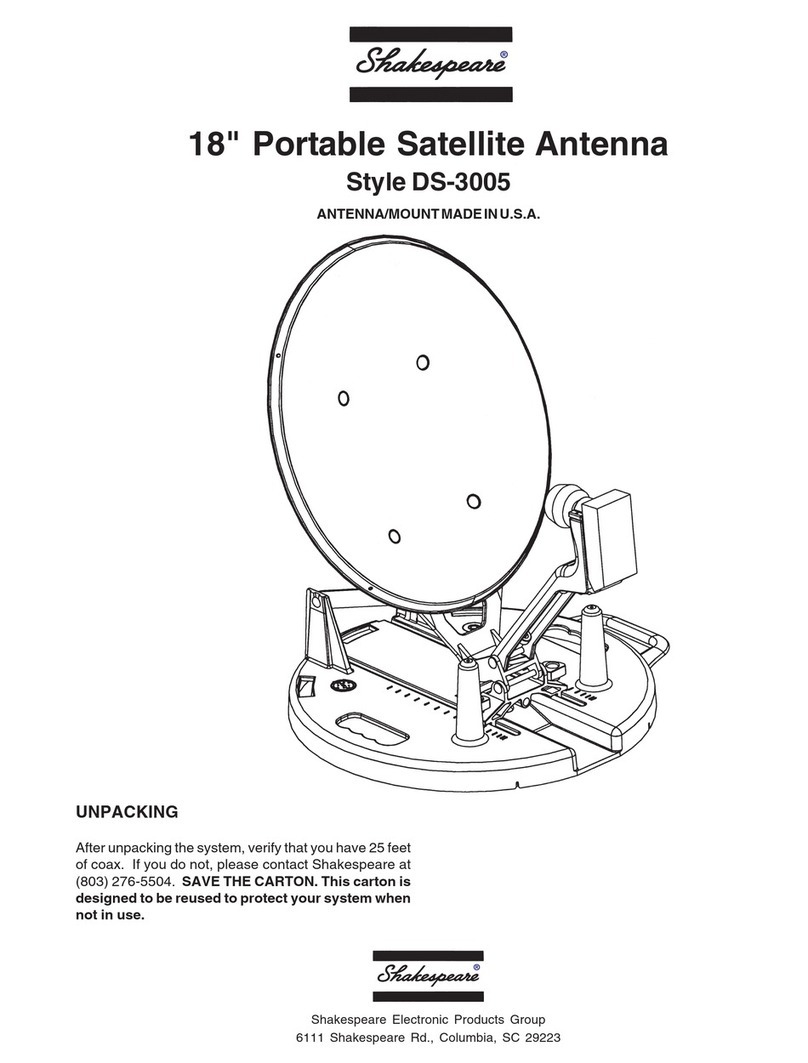
Shakespeare Electronic
Shakespeare Electronic Style DS-3005 user manual
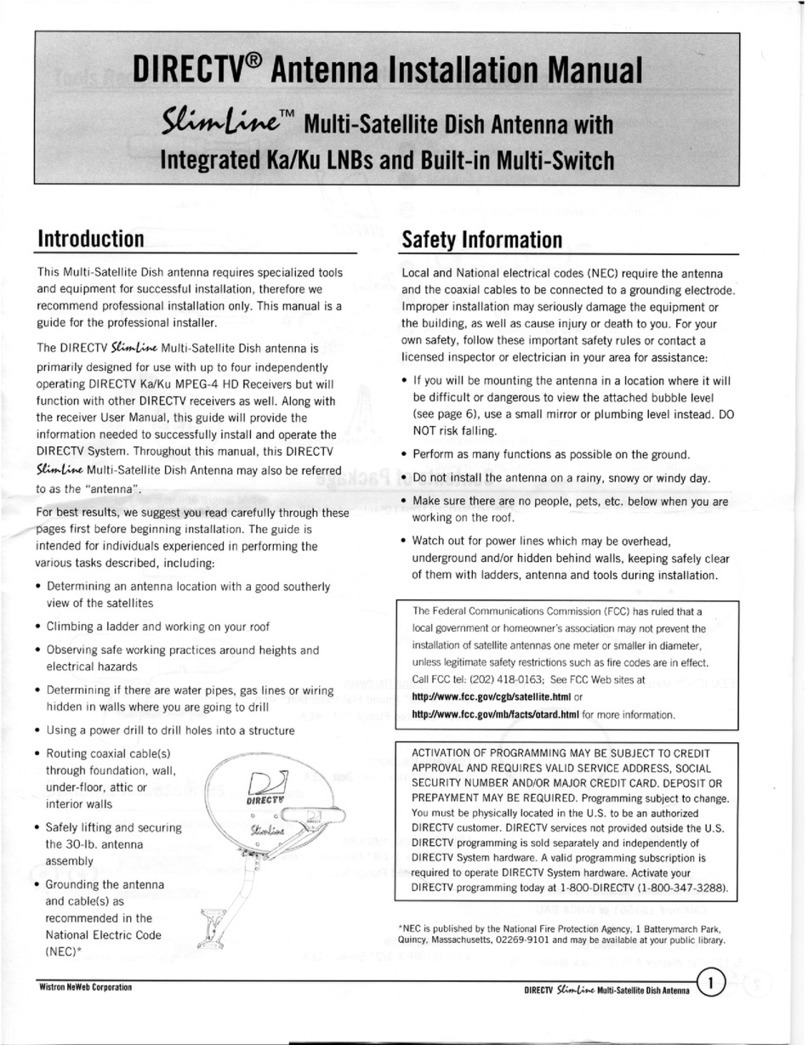
DirecTV
DirecTV SlimLine installation manual
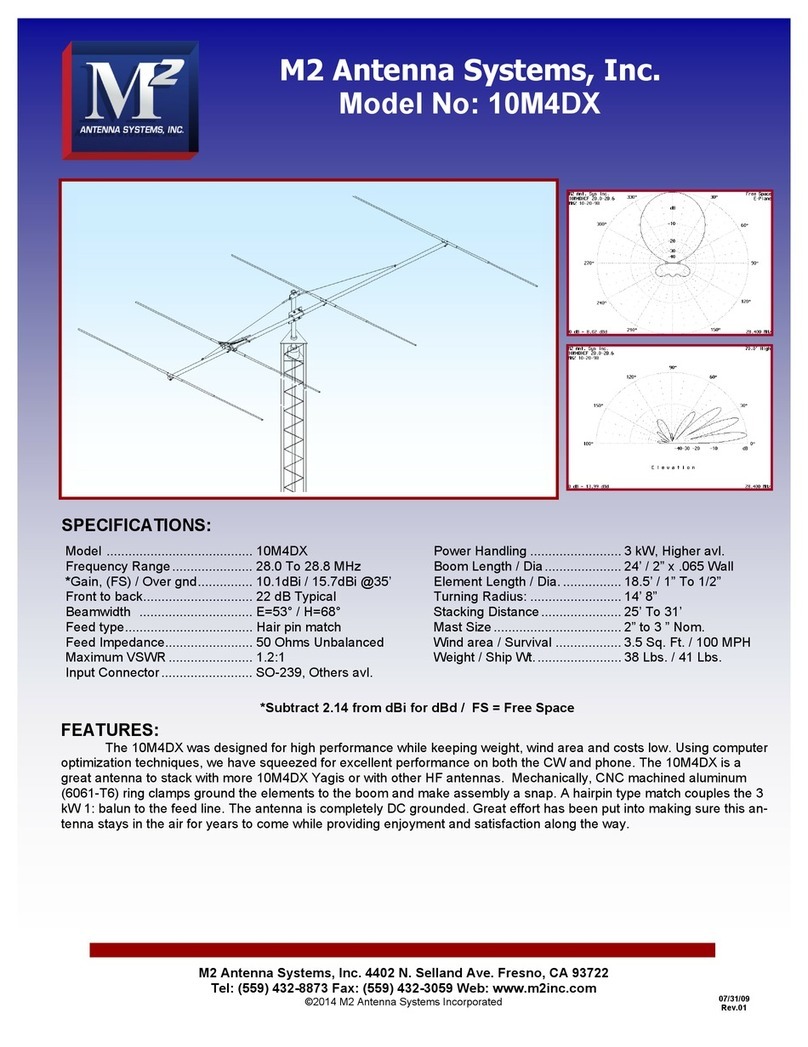
M2 Antenna Systems
M2 Antenna Systems 10M4DX Assembly manual
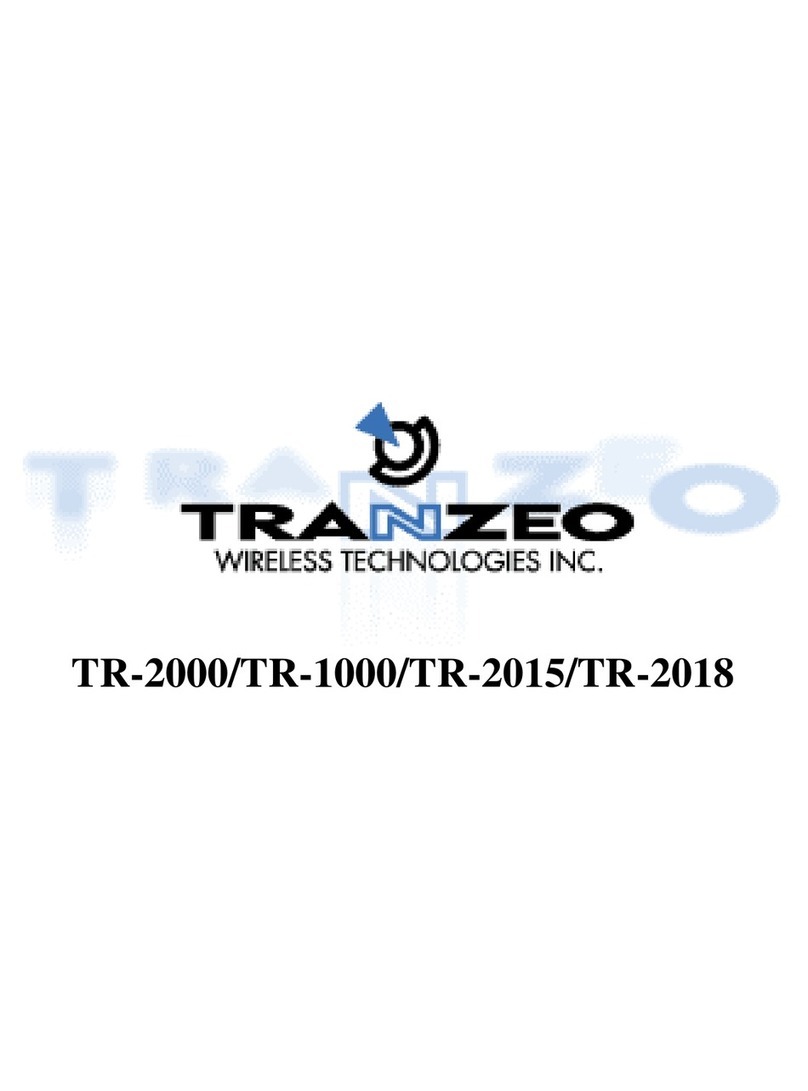
Tranzeo Wireless Technologies
Tranzeo Wireless Technologies TR-2000 manual

prodelin
prodelin 1183 series Assembly manual

Metronic
Metronic ES439 instructions

